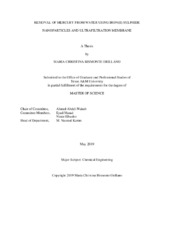| dc.contributor.advisor | Abdel-Wahab, Ahmed | |
| dc.creator | Orillano, Maria Christina Bismonte | |
| dc.date.accessioned | 2019-10-15T17:19:25Z | |
| dc.date.accessioned | 2023-03-09T16:06:52Z | |
| dc.date.available | 2023-03-10T08:36:21Z | |
| dc.date.created | 2019-05 | |
| dc.date.issued | 2019-03-07 | |
| dc.date.submitted | May 2019 | |
| dc.identifier.uri | https://hdl.handle.net/1969.1/184429 | |
| dc.description.abstract | In this study, reactive nanoparticulate FeS was used to remove Hg(II) from water with an ultrafiltration system. A dead-end ultrafiltration (DE/UF) system was developed to remove Hg(II)- contacted FeS from water in the presence of 0.01M anions (Cl- , NO3 - , SO4 2- ) and 1 mg/L HA in non-stirred mode using regenerated cellulose membrane. The DE/UF stirred mode was applied to evaluate the ‘shear effect’ on the rejection of Hg-contacted FeS. Batch tests reveal that complete Hg(II) removal was achieved in 10 minutes in the presence of anions and 60 minutes in the presence of HA. A cross-flow ultrafiltration (CF/UF) system was implemented to examine continuous removal of Hg-contacted FeS in the presence of 0.01 M anions using 1000 kDa polyethersulfone membrane. Experimental results showed that in the presence of anions, higher Hg(II) removal was observed compared to Hg(II) and FeS alone with slight decrease in pH and increased flux decline. The highest Hg(II) removal was achieved in the presence of HA with no pH effect despite significant impact on membrane permeability and slight Fe released during the desorption tests. The DE/UF stirred mode system exhibited reduced cake formation leading to less flux decline. In terms of membrane pore size, 100 and 300 kDa exhibited significant flux recovery despite greater flux decline compared to 30 kDa. Overall, the developed ultrafiltration systems produced chemically stable Hg-contacted FeS particles that can be reused and disposed safely in the environment. In the DE/UF system nonstirred mode, Hg-contacted FeS achieved complete additional Hg(II) removal. However, the DE/UF stirred mode and the CF/UF system exhibited decreased additional removal capacity. These could be due to chemical variations in the FeS particles caused by the shear effect and tangential flow on the Hg(II)-contacted FeS. SEM/EDS analyses demonstrate that the Hg loading on the membrane was higher in the presence of humic acid and anions. These findings present fundamental data that could be applied in the advancement of Hg(II)-contaminated water treatment using low cost FeS adsorbents and can serve as a guideline for continuous treatment of other toxic inorganic chemicals. | en |
| dc.format.mimetype | application/pdf | |
| dc.language.iso | en | |
| dc.subject | Hg(II) removal from water | en |
| dc.subject | FeS | en |
| dc.subject | Ultrafiltration | en |
| dc.subject | Anions | en |
| dc.subject | Humic Acid | en |
| dc.subject | Dead-End Ultrafiltration | en |
| dc.subject | Cross-Flow Ultrafiltration | en |
| dc.title | Removal of Mercury From Water Using Iron(II) Sulphide Nanoparticles and Ultrafiltration Membrane | en |
| dc.type | Thesis | en |
| thesis.degree.department | Chemical Engineering | en |
| thesis.degree.discipline | Chemical Engineering | en |
| thesis.degree.grantor | Texas A & M University | en |
| thesis.degree.name | Master of Science | en |
| thesis.degree.level | Masters | en |
| dc.contributor.committeeMember | Masad, Eyad | |
| dc.contributor.committeeMember | Elbashir, Nimir | |
| dc.type.material | text | en |
| dc.date.updated | 2019-10-15T17:19:27Z | |
| local.embargo.terms | 2021-05-01 | |
| local.etdauthor.orcid | 0000-0003-3930-5736 | |


